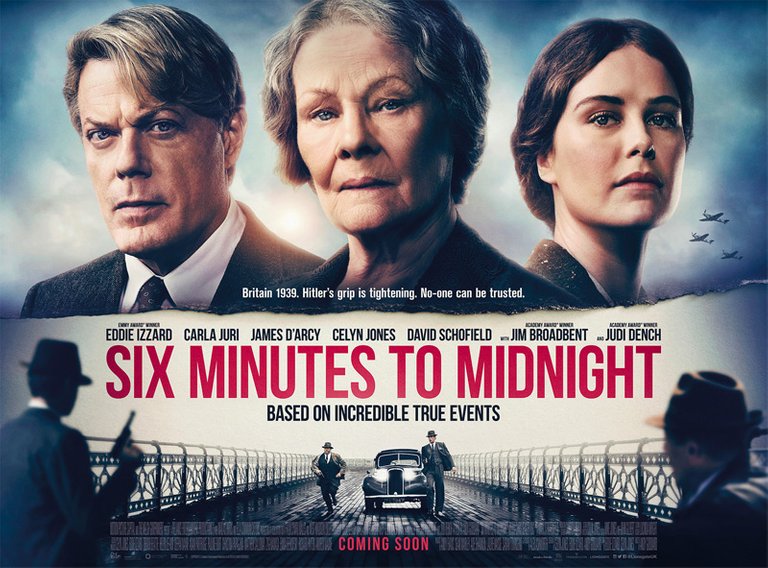Six Minutes to Midnight, a reconnaissance drama which is actually directed by Andy Goddard and featuring Eddie Izzard and Judi Dench, has a delicate soul that you don't anticipate from a period spy thrill ride—yet at that point, there aren't many government agent spine chillers with risked students at their middle. It's August of 1939, and England is near the very edge of a conflict whose scope it can't yet envision. Izzard plays an instructor, Thomas Miller, who accepts a position at Augusta-Victoria College, a completing school in the beach front town of Bexhill-on-Sea that is kind of a culturally diverse examination among England and Germany. The participants are on the whole youthful German ladies from "great" families, potentially the girls, nieces or goddaughters of Nazi authorities. But on the other hand they're simply young ladies, teens, and the school's headmistress, Miss Rocholl (Judi Dench), has an incredible arrangement put resources into giving them appropriate English instruction, just as basically guarding them. Indeed, even with her compatriots getting progressively dubious, in light of current circumstances, of everything German, Miss Rocholl demands putting stock in the fundamental fairness of her young charges.
However the school is in strife. The school's previous English educator has strangely vanished; Miller is to be his substitution, and Miss Rocholl gets him through a cold, unpleasant meeting prior to recruiting him. Miss Rocholl's correct hand lady, Ilse (Carla Juri), appears to be sufficiently cordial, however there's a clandestine thing about her too. Furthermore, after a mistake on a blustery evening, Miller gets himself a homicide suspect, on the run from the police, and entangled in an undercover work plot. Similarly as the entire country is tense, this appropriate little school has likewise been shaken to its center.
Judi Dench in 'Six Minutes to Midnight'
Judi Dench in 'Six Minutes to Midnight' Courtesy of IFC Films
Six Minutes to Midnight was composed by Goddard, Izzard and Celyn Jones, and its subject has uncommon importance for Izzard: Her family is from Bexhill-on-Sea, and she invested a lot of energy there as a kid. (Izzard uncovered in December that she is transsexual and utilizations she/her pronouns.) The Augusta-Victoria College was a genuine school, in activity from 1932 to 1939; the identifications on the young ladies' garbs, duplicated in the film, highlighted a lion wild flanked by both a Union Jack and an insignia. The thought for Six Minutes to Midnight arose out of Izzard's interest with the school.
As convincing as the crude thought might be, the plot of Six Minutes to Midnight might have been all the more finely tuned. In her commitment to her charges, Miss Rocholl is altogether too ignorant concerning the perils they may posture to her own country; while a portion of the young ladies appear to be truly blameless and guileless, others have obviously been educated in Nazi beliefs. (A scene wherein a character stuns the young ladies with a crisp talk about enemy of Semitism causes them to appear to be more confused than some prior scenes have persuaded.)
In any case, the film is still discreetly engaging, and there's an ardent thing about its methodology—it appears to be guided by a longing to accept that youngsters' perspectives can be formed and diverted for the better by straightforward benevolence. Izzard, so particularly amazing as a live entertainer, is consistently amusing to watch onscreen: As Miller, she has an energetic, curious energy. (In an early scene, Miller prevails upon his fairly unpleasant new understudies by showing them a past English music-lobby tune, "It's a Long Way to Tipperary.") And as shot by Chris Seager, the film is lovely to take a gander at, giving us seascapes and rocky precipices with a marvelous, cloudy edge, as though they were some way or another mindful of our essence, seeing them from our vantage point nearly 60 years later.
The ocean and its encompassing rocks are highlights of the regular world that have borne observer to sights we may never have longed for, including perfect lines of youthful German young ladies, in dark swimsuits and white covers, taking off into the white-tipped waves for a dip. Six Minutes to Midnight is a recognition for those genuine young ladies who, as visitors from a land that would before long turn into a horrible adversary, address a peculiar little crossing point of English and German history—the human component behind images conflicting on an identification.
